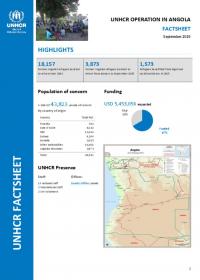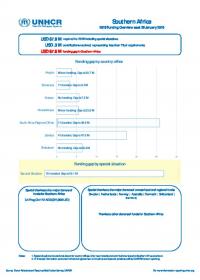Operations

OPERATIONS
Africa
- Central Africa and the Great Lakes
- Burundi
- Cameroon
- Central African Republic
- Congo
- Democratic Republic of the Congo
- Rwanda
- United Republic of Tanzania
- East and Horn of Africa
- Southern Africa
- West Africa
Americas
Asia and the Pacific
Europe
Middle East and North Africa
NEW: 2016 planning information has just been released. Budgets and population planning figures for 2016 and for previous years can be reviewed below. The French version is available in pdf format.
Location
{"longitude":18,"latitude":-12,"zoom_level":0}
Latest update of camps and office locations 13 January 2016. By clicking on the icons on the map, additional information is displayed.
Operational Highlights
Operational context and population trends
Immigration control is gaining prominence on the political agenda in Angola as the country’s expanding economy continues to attract foreign workers.
According to data provided by the Service for Migration and Foreigners, housed in the Ministry of the Interior, by the end of 2014:
In 2016, the number of refugees is expected to increase as the national refugee status determination (RSD) body is holding regular sessions and is seeking to reduce the backlog of asylum applications. In spite of the possible cessation clause that may be invoked for Liberians and Sierra Leoneans, the number of refugees may reach up to 20,000.
Key priorities in 2016
UNHCR will continue to support the Government of Angola as its main counterpart by:
Immigration control is gaining prominence on the political agenda in Angola as the country’s expanding economy continues to attract foreign workers.
According to data provided by the Service for Migration and Foreigners, housed in the Ministry of the Interior, by the end of 2014:
- 59,905 people of concern to UNHCR are living in Angola, of whom 15,474 are refugees, 30,147 are asylum-seekers and 14,284 are Angolan returnees
- The refugee population in Angola originates mainly from the Democratic Republic of Congo (DRC) Katangese, Rwanda, Sierra Leone, Ivory Coast, Sudan and Somalia. The Government of Angola has been informed about the possible cessation clause for Liberian, Sierra Leonean and Rwandan refugees, but has yet to issue a formal decision on the matter, and an exemption procedure has yet to be established
- The population group of asylum-seekers is comprised of 32 different nationalities.
In 2016, the number of refugees is expected to increase as the national refugee status determination (RSD) body is holding regular sessions and is seeking to reduce the backlog of asylum applications. In spite of the possible cessation clause that may be invoked for Liberians and Sierra Leoneans, the number of refugees may reach up to 20,000.
Key priorities in 2016
UNHCR will continue to support the Government of Angola as its main counterpart by:
- Improving of the effectiveness of the national RSD body through training
- Collecting reliable refugee data
- Developing and issuing improved identity documents for asylum-seekers and refugees
- Supporting people of concern with special needs and community self-management
- Capacitating Angolan authorities in developing adequate legislation and policy aimed at establishing a favourable protection environment.
Stories
People of Concern
32%
Increase in
2014
2014
| 2014 | 59,970 |
| 2013 | 45,488 |
| 2012 | 63,473 |

[["Refugees",15474],["Asylum-seekers",30212],["Returned refugees",14284]]
Loading ...
Budgets and Expenditure for Angola
< Back
2014
{"categories":[2012,2013,2014,2015,2016],"budget":[9.84500068,4.69733169,5.76081952,5.45305636,3.73148992],"expenditure":[6.14939035,3.58025033,4.43620524,null,null]}
{"categories":[2012,2013,2014,2015,2016],"p1":[9.84500068,4.69733169,5.76081952,5.45305636,3.73148992],"p2":[null,null,null,null,null],"p3":[null,null,null,null,null],"p4":[null,null,null,null,null]}
{"categories":[2012,2013,2014,2015,2016],"p1":[6.14939035,3.58025033,4.43620524,null,null],"p2":[null,null,null,null,null],"p3":[null,null,null,null,null],"p4":[null,null,null,null,null]}
Loading ...



